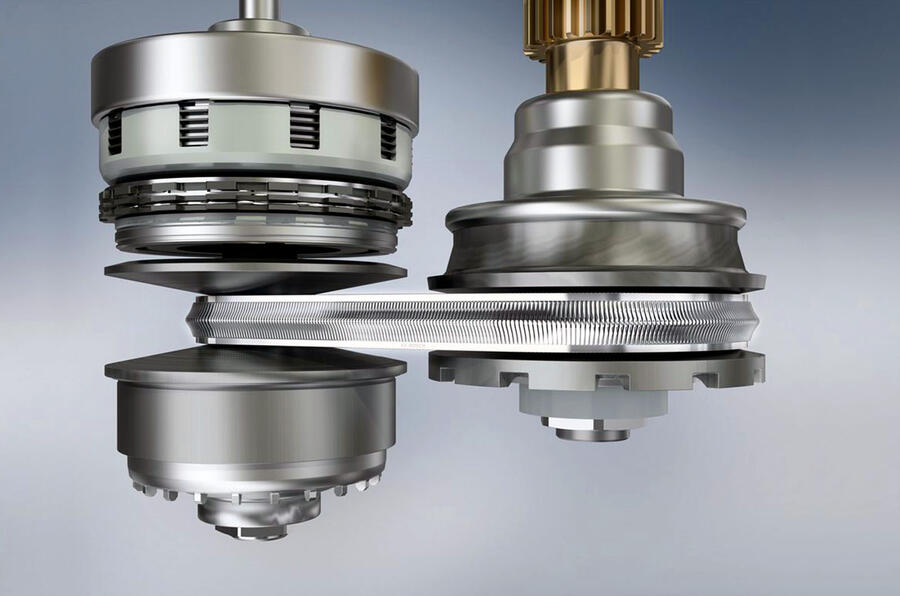
Sometimes called a shiftless transmission or a pulley transmission a CVT is a type of automatic transmission that utilizes variable-width pulleys and a flexible belt as opposed to fixed gears like a regular automatic transmission. A conventional automatic transmission uses a set number of low medium and high gear ratios to send the engines power to the wheels.

A conventional automatic transmission uses a set number of low medium and high gear ratios to send the engines power to the wheels.
How cvt transmission work. Heres how it works. One disc connects to the engine. This is equivalent to the driving pulley.
Another disc connects to the drive shaft. This is equivalent to the driven pulley. Rollers or wheels located between the discs act like the belt transmitting power from one disc to the other.
While a traditional transmission uses a wide variety of intricate parts to shift between a range of preset gears most CVT systems work through a pulley system. In short this system consists of. See the parts of a CVT in operation000 Start015 Drive pulley 020 Driven Pulley 023 Steel push belt 030 Input shaft 040 Reverse clutch 048 Forward clu.
Even if you dont know much about how a transmission works you have probably heard of the manual and the automatic. The CVT is the newest type of transmission. A conventional automatic transmission uses a set number of low medium and high gear ratios to send the engines power to the wheels.
A CVT has no gears at all. It uses two variable-width pulleys connected by a flexible belt. One pulley is also connected to the engine while the other is connected to the wheels.
A CVT continuously variable transmission is a type of automatic transmission that has an indefinite number of gear ratios. While a conventional automatic has a fixed number of gears 4 gears for a four speed 6 gears for a six speed etc a CVT can form any number and combination of gears based on its mechanical limits and the transmission control units programming. Continuously Variable Transmission CVT is a transmission mode youll find in many adult ATVs.
The designs focus is to keep the engine within the best possible rpm range at all times. Once the engine is within this range it will work more efficiently and produce the maximum power necessary for a given scenario. CVTs are operated just like conventional automatic transmissions.
At first you slide the shift lever from P to D and off you go. However it gets a bit complicated afterwards. Regular automatics have a fixed number of gears that are known as speeds hence the term 6-speed automatic for instance.
A CVT continuously variable transmission is a single-speed transmission that works like an automatic shifter for seamless shifting through a range of gear ratios unlike other mechanical shifters that offer access to a fixed number of gear ratios. The e-CVT transmission uses a planetary gearset and two electric-motor generators to continuously change gears. In my experience this gearbox is superior in terms of reliability I never encountered an issue with one.
Continuously variable transmissions operate via a system of pulleys or rollers instead of gears. One pulley connects to the engine the other to the transmission. Through a clever mechanism the pulleys are able to adjust as needed to stay in the ideal range needed to distribute power from the engine to the vehicle.
IN A NUTSHELL a continuously variable transmission or CVT doesnt offer fixed gear ratios like a either a manual gearbox automatic transmission or a DSG Direct Sequential Gearbox a newer type of auto. Rather the CVT allows the vehicles engine to run at its most efficient revolutions per minute RPM for a range of vehicle speeds. How Does a CVT Work.
To allow the engine to stay at the same RPM while the car accelerates the gearbox has to change the gears inside. This is usually done via two different pulleys. One of these is driven by the engine while the other will drive the output shafts.
Sometimes called a shiftless transmission or a pulley transmission a CVT is a type of automatic transmission that utilizes variable-width pulleys and a flexible belt as opposed to fixed gears like a regular automatic transmission. A CVT is technically an automatic gearbox because it doesnt require the use of a clutch to change gears but the major difference is that it does not have any conventional fixed gears. The CVT manual mode and paddles work in concert and are an excellent option to have in a performance context.
The driver can downshift with the left paddle and bump the shifter on the center. A Continuously Variable Transmission CVT provides simple efficient power delivery creating better fuel economy than traditional transmissions. With CVT shifting is seamless the vehicle performs as though it has a variable gear for every driving situation and you wont feel any shift shock.